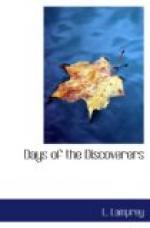All the next day they waited, but nothing happened. On the morning after, a large number of boats appeared rounding the headland to the south. In the largest sat the Sagem, a very old man wrapped in furs. The boats were made of birchbark laced on a wooden framework with fibrous roots, like the toy skiff Mother Elle had made for little Peder.
The Skroelings landed, and advanced with great dignity to meet Knutson, who was equally ceremonious. Nils and Thorolf had all they could do to interpret the old chief’s long speech, although many phrases were repeated again and again, which made it easier. Knutson made one in reply, briefer but quite as polite, and brought out beads, little knives, and scarlet cloth from his trading stores. The red cloth and beads were received with eagerness, the knives with interest, and after a young chief had cut himself, with some awe. The Sagem in his turn presented the stranger with skins of the sable, the silver fox and the bear. He and a few of the warriors tasted of the food offered them, and all the white men were asked to a feast in the village the next day.
So friendly were the Skroelings, in fact, that Knutson determined to return to Greenland and see what could be done toward founding a settlement here. He would leave part of the men in winter quarters, with the Rotge as a means of further explorations, or if necessary, of escape. Her captain, Gustav Sigerson, was a cautious, wise and experienced seaman. Anders Amundson, as the best hunter of the expedition, was to stay, with Nils as clerk and Thorolf as interpreter. Booths were erected, stores landed, and on a brilliant day in late summer some forty Norsemen and Gothlanders on the shore watched the Gudrid slowly fading out of sight.
In talking with the natives Nils and Thorolf observed that their world seemed to be infested with demons—particularly water-fiends. A reason for this appeared in time. Half a dozen men one day took the stern-boat and went a-fishing. They came back white-faced, with a story of a giant squid with arms four times as long as the boat, that had risen out of the sea and tried to pull them under. Only their skill as rowers had saved them. Nils remembered the kraken, of ancient legends, and thought he could see why the Skroelings never ventured out to sea in their frail canoes. This put an end to plans for exploring along the coast.
The winter was colder than they had expected. This land, so much further south than Norway, was bitten by frost as Norway never was. There is something in intense cold which is inhuman. When men are shut up together in exile by it, all that is bad in them is likely to crop out. It might have been worse but for the fortunate friendliness of the Skroelings. When scurvy appeared in the camp, their first acquaintance, Munumqueh (woodchuck) had his women brew a drink which cured it. He showed the white men also how to make pemmican, the compressed meat ration of native hunters, and how to construct and use a birch canoe, a pair of snowshoes, and a fire-drill. Gustav Sigerson died in the spring, and Nils was chosen captain. He and Munumqueh became great cronies, and exchanged names, Nils being thereafter known to his native friends as the Woodchuck, and bestowing upon Munumqueh the proud name of his grandfather, Nils the Bear-Slayer.




